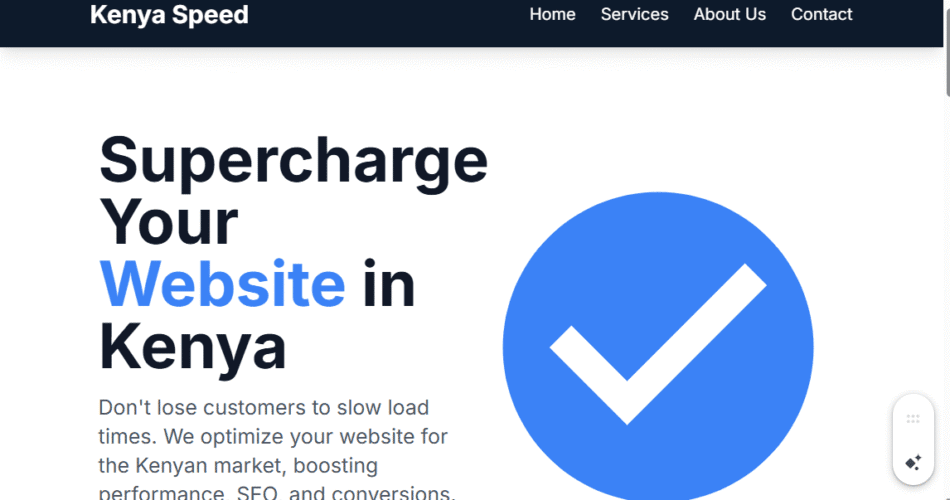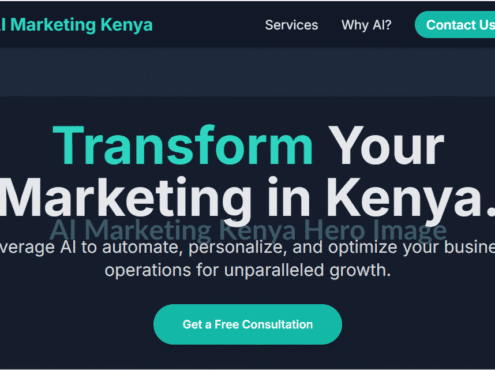Website Speed Optimization Kenya:
-
Delivery Time2 Weeks
-
English levelProfessional
-
LocationUnited Kingdom, United Arab Emirates, Nairobi, Kilimani, Kenya, Dubai, CBD Nairobi, Canada
Service Description
The cost of Website Speed Optimization in kenya is 200000KES.Get Website Speed Optimization in kenya at a price of 150000KES at Black Shepherd Technologies.
Boost your website’s performance in Kenya with expert speed optimization. We offer comprehensive solutions including image compression, code minification, and CDN implementation to slash loading times, improve SEO rankings, and enhance user experience. Get a lightning-fast website that converts visitors into customers.
In the dynamic digital landscape of Kenya, a fast-loading website is not just a luxury; it’s a necessity for business survival and growth. Website speed optimization in Kenya is a critical process that enhances user experience, boosts search engine rankings, and ultimately drives conversions. A slow website, plagued by long loading times, high bounce rates, and frustrated visitors, can severely hinder a company’s online performance. This comprehensive guide delves into the crucial aspects of website speed optimization tailored for the Kenyan market, offering actionable strategies to transform your website from sluggish to lightning-fast.
The journey to a faster website begins with a thorough analysis of its current performance. Tools like Google PageSpeed Insights, GTmetrix, and Pingdom can provide invaluable insights into your site’s loading times, identifying specific areas that need improvement. These reports often highlight issues such as large image files, unoptimized code, inefficient server responses, and excessive third-party scripts. Addressing these “pain points” is the first step toward a more efficient and user-friendly website.
One of the most impactful strategies for website speed optimization is image optimization. High-resolution, uncompressed images are often the primary culprits behind slow page loads. By compressing images without sacrificing quality, resizing them to the appropriate dimensions, and using modern formats like WebP, you can significantly reduce the data transferred to the user’s browser. Tools like TinyPNG and Squoosh make this process straightforward and highly effective.
Another key area to focus on is code optimization. Minifying CSS, JavaScript, and HTML files by removing unnecessary characters, whitespace, and comments can dramatically decrease their file sizes. Combining multiple CSS and JavaScript files into a single file can also reduce the number of HTTP requests a browser has to make, leading to faster loading times. As many Kenyan websites are built on platforms like WordPress, leveraging caching plugins like WP Rocket or W3 Total Cache can be a game-changer. These plugins create static versions of your pages, which are served to visitors much faster than dynamically generated pages, especially during peak traffic times.
The choice of hosting provider also plays a pivotal role in website performance. A reliable and fast web host with servers located geographically closer to your target audience (in this case, Kenya) can significantly reduce latency and improve loading speeds. Consider providers with solid-state drives (SSDs) and content delivery networks (CDNs). A CDN, with its network of servers distributed globally, caches your website’s content and delivers it from the server closest to the user, ensuring a consistently fast experience for visitors across Kenya and beyond.
Mobile optimization is non-negotiable in a country like Kenya, where a significant portion of internet users access the web via smartphones. A fast, responsive, and mobile-friendly design is essential for engaging this vast audience. Google’s mobile-first indexing means that a website’s mobile performance is a primary factor in its search engine ranking. Therefore, optimizing for mobile devices—ensuring fast loading on 3G and 4G networks, and providing a seamless user interface—is critical for success.
Furthermore, implementing browser caching and leveraging server-side solutions can provide an extra boost. Browser caching allows returning visitors to access a cached version of your site, eliminating the need to download all assets again. This results in an almost instantaneous loading experience. On the server side, enabling Gzip compression, which compresses files before they are sent to the browser, can also contribute to faster data transfer.
Ultimately, website speed optimization is an ongoing process that requires continuous monitoring and refinement. Regularly testing your website’s performance, keeping your plugins and themes updated, and adopting new technologies as they emerge are all part of maintaining a fast and efficient online presence. For Kenyan businesses aiming to stay competitive, a fast-loading website is a powerful asset that builds trust, reduces bounce rates, improves SEO, and drives higher conversions. Investing in website speed optimization is not just a technical task; it’s a strategic business decision that pays dividends in the long run.The choice of hosting provider also plays a pivotal role in website performance. A reliable and fast web host with servers located geographically closer to your target audience (in this case, Kenya) can significantly reduce latency and improve loading speeds. Consider providers with solid-state drives (SSDs) and content delivery networks (CDNs). A CDN, with its network of servers distributed globally, caches your website’s content and delivers it from the server closest to the user, ensuring a consistently fast experience for visitors across Kenya and beyond.
Mobile optimization is non-negotiable in a country like Kenya, where a significant portion of internet users access the web via smartphones. A fast, responsive, and mobile-friendly design is essential for engaging this vast audience. Google’s mobile-first indexing means that a website’s mobile performance is a primary factor in its search engine ranking. Therefore, optimizing for mobile devices—ensuring fast loading on 3G and 4G networks, and providing a seamless user interface—is critical for success.
Furthermore, implementing browser caching and leveraging server-side solutions can provide an extra boost. Browser caching allows returning visitors to access a cached version of your site, eliminating the need to download all assets again. This results in an almost instantaneous loading experience. On the server side, enabling Gzip compression, which compresses files before they are sent to the browser, can also contribute to faster data transfer.
Ultimately, website speed optimization is an ongoing process that requires continuous monitoring and refinement. Regularly testing your website’s performance, keeping your plugins and themes updated, and adopting new technologies as they emerge are all part of maintaining a fast and efficient online presence. For Kenyan businesses aiming to stay competitive, a fast-loading website is a powerful asset that builds trust, reduces bounce rates, improves SEO, and drives higher conversions. Investing in website speed optimization is not just a technical task; it’s a strategic business decision that pays dividends in the long run.
Conclusion:
In a market where digital connectivity is expanding and a large percentage of the population is mobile-first, a fast-loading website is no longer an optional feature. With a median mobile internet speed of 21.78 Mbps as of early 2024, Kenyan users expect a seamless and quick Browse experience. The data shows that 53% of mobile users abandon a site if it takes longer than 3 seconds to load, making every millisecond count. For Kenyan businesses, a slow website translates directly into lost opportunities, lower search engine rankings, and a damaged brand reputation. By adopting the strategies outlined above—from image and code optimization to strategic hosting and mobile-first design—businesses can not only meet but exceed user expectations. Investing in website speed optimization is a strategic imperative that ensures your online presence is robust, competitive, and ready to capture the growing digital market in Kenya. It is the key to unlocking higher engagement, better conversions, and sustainable long-term growth.








